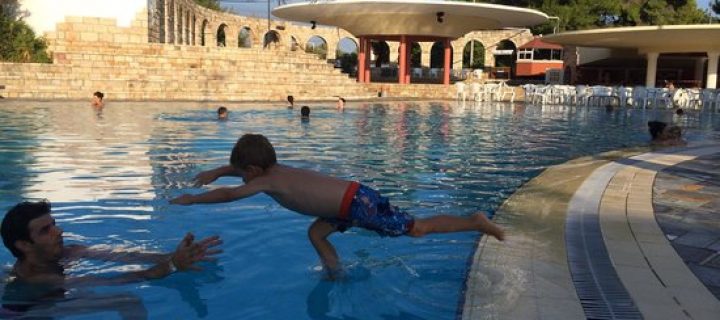Are they helping your child swim, or hindering them and making it unsafe?
If you’re the parent of a child learning to swim, the sight of water wings can be very enticing-you know, those inflatable plastic things you can stick on their arms to help them float.
Water wings may appear to be a tool that can make your life simpler in the water, and give your child a good dose of fun. but it’s complicated. Here’s our take.
The Cons:
1) They Create a False Sense of Security
Water wings definitely come with some drawbacks. If you put them on your child, you and they may develop a false sense of security in the water. You might feel more comfortable letting them float around on their own, while you check your phone for a moment. Bad idea.
Related: Why Swimming After Dinner is Often a Favorite Part of My Day
The CDC doesn’t recommend water wings for use as a safety device, and neither do we. If your child can’t swim on their own, you need to be in the water with them, and within touching length at all times whether they have water wings on or not.
2) Some Can be Easily Removed
Depending on the type you use, you’ll find that some water wings slip off the arms easily. If you’re going to use them, get the type that’s made like a jacket and does up at the back.
3) They Can Burst
If they’re filled with air, they’re susceptible to punctures. Not safe for non-swimmers.
4) They Can Make it Hard to Roll Over
Again, depending on the type of wings you use, if your child does end up face down in the water, the wings can make it difficult for them to roll over. Beware.
The Pros:
Confidence
You’re now likely running from water wings like your hair is on fire. Let it be known however, there are some benefits to using them. We’ve used water wings on our preschooler for a couple of years and he loves them. But here’s the thing: we’re always in the water with him and at arm’s length, or holding him. Always.
Basically, using the wings makes it easier for us to ‘go swimming’. As parents, we don’t have to hold our son under his arms at all times, when in the water. He floats a bit on his own. Using the wings has given him a brief introduction to feeling confident and “independent” in the pool, which is a good thing.
And we’ve now enrolled him in swimming lessons. He’s learning to put his face in and spend time underwater.
As soon as our son can swim on his own, the wings will be gone. And we would never place him in water with the wings on without one of us in there at his side. In essence, we use them for fun and not for safety.
What’s your take, yay or nay? Have fun in the sun and swim safely.
Photo credits: sirtravelalot/Shutterstock.com












